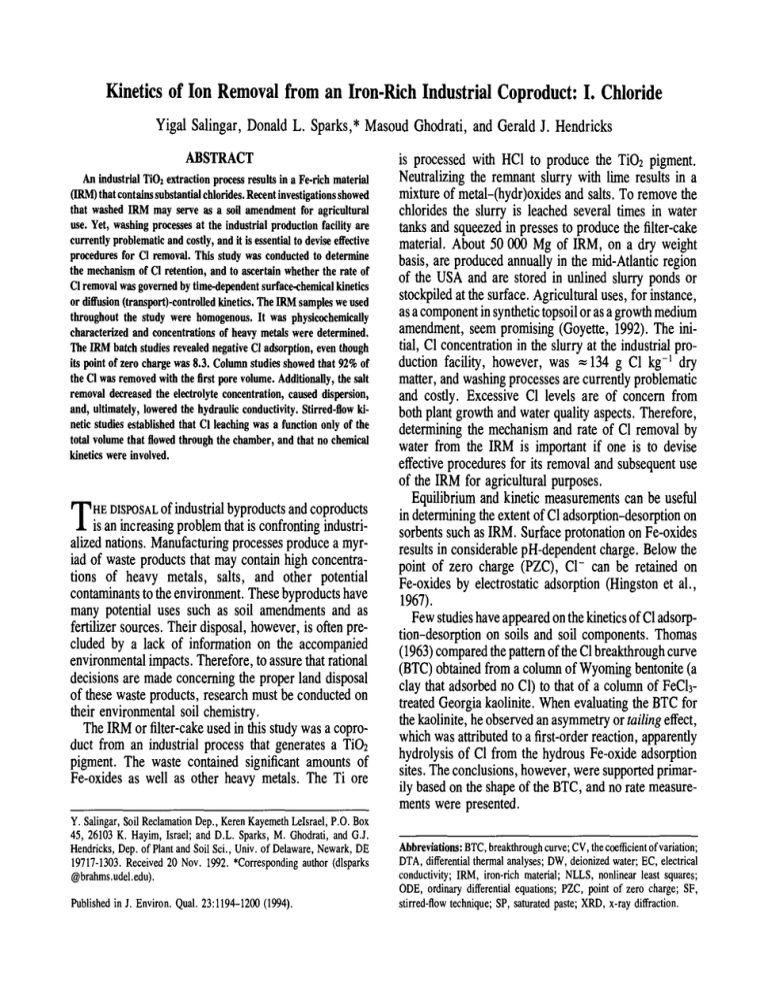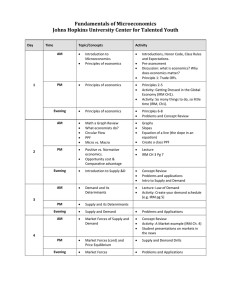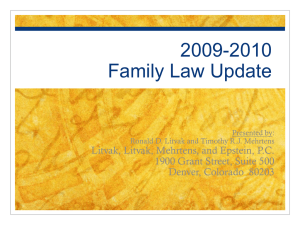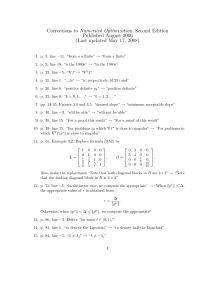Kinetics of Ion Removal from an Iron-Rich Industrial Coproduct: I....
advertisement

Kinetics of Ion Removal from an Iron-Rich Industrial Coproduct: I. Chloride Yigal Salingar, Donald L. Sparks,* Masoud Ghodrati, and Gerald J. Hendricks ABSTRACT An industrial TiO2 extraction process results in a Fe-rich material (IRM) that contains substantial chlorides. Recent investigations showed that washed IRM may serve as a soil amendment for agricultural use. Yet, washing processes at the industrial production facility are currently problematic and costly, and it is essential to devise effective procedures for Cl removal. This study was conducted to determine the mechanism of Cl retention, and to ascertain whether the rate of Cl removal was governed by time-dependent surface-chemical kinetics or diffusion (transport-controlled kinetics. The IRM samples we used throughout the study were homogenous. It was physicochemically characterized and concentrations of heavy metals were determined. The IRM batch studies revealed negative Cl adsorption, even though its point of zero charge was 8.3. Column studies showed that 92% of the Cl was removed with the first pore volume. Additionally, the salt removal decreased the electrolyte concentration, caused dispersion, and, ultimately, lowered the hydraulic conductivity. Stirred-flow kinetic studies established that Cl leaching was a function only of the total volume that flowed through the chamber, and that no chemical kinetics were involved. T HE DISPOSAL of industrial byproducts and coproducts is an increasing problem that is confronting industrialized nations. Manufacturing processes produce a myriad of waste products that may contain high concentrations of heavy metals, salts, and other potential contaminants to the environment. These byproducts have many potential uses such as soil amendments and as fertilizer sources. Their disposal, however, is often precluded by a lack of information on the accompanied environmental impacts. Therefore, to assure that rational decisions are made concerning the proper land disposal of these waste products, research must be conducted on their environmental soil chemistry. The IRM or filter-cake used in mis study was a coproduct from an industrial process that generates a TiCh pigment. The waste contained significant amounts of Fe-oxides as well as other heavy metals. The Ti ore Y. Salingar, Soil Reclamation Dep., Keren Kayemeth Lelsrael, P.O. Box 45, 26103 K. Hayim, Israel; and D.L. Sparks, M. Ghodrati, and G.J. Hendricks, Dep. of Plant and Soil Sci., Univ. of Delaware, Newark, DE 19717-1303. Received 20 Nov. 1992. *Corresponding author (dlsparks @brahms. udel.edu). Published in J. Environ. Qual. 23:1194-1200 (1994). is processed with HC1 to produce the TiO2 pigment. Neutralizing the remnant slurry with lime results in a mixture of metal-(hydr)oxides and salts. To remove the chlorides the slurry is leached several times in water tanks and squeezed in presses to produce the filter-cake material. About 50 000 Mg of IRM, on a dry weight basis, are produced annually in the mid-Atlantic region of the USA and are stored in unlined slurry ponds or stockpiled at the surface. Agricultural uses, for instance, as a component in synthetic topsoil or as a growth medium amendment, seem promising (Goyette, 1992). The initial, Cl concentration in the slurry at the industrial1 production facility, however, was »134 g Cl kg" dry matter, and washing processes are currendy problematic and costly. Excessive Cl levels are of concern from both plant growth and water quality aspects. Therefore, determining the mechanism and rate of Cl removal by water from the IRM is important if one is to devise effective procedures for its removal and subsequent use of the IRM for agricultural purposes. Equilibrium and kinetic measurements can be useful in determining the extent of Cl adsorption-desorption on sorbents such as IRM. Surface protonation on Fe-oxides results in considerable pH-dependent charge. Below the point of zero charge (PZC), Cl" can be retained on Fe-oxides by electrostatic adsorption (Hingston et al., 1967). Few studies have appeared on the kinetics of Cl adsorption-desorption on soils and soil components. Thomas (1963) compared the pattern of the Cl breakthrough curve (BTC) obtained from a column of Wyoming bentonite (a clay mat adsorbed no Cl) to that of a column of FeChtreated Georgia kaolinite. When evaluating the BTC for the kaolinite, he observed an asymmetry or tailing effect, which was attributed to a first-order reaction, apparently hydrolysis of Cl from the hydrous Fe-oxide adsorption sites. The conclusions, however, were supported primarily based on the shape of the BTC, and no rate measurements were presented. Abbreviations: BTC, breakthrough curve; CV, the coefficient of variation; DTA, differential thermal analyses; DW, deionized water; EC, electrical conductivity; IRM, iron-rich material; NLLS, nonlinear least squares; ODE, ordinary differential equations; PZC, point of zero charge; SF, stirred-flow technique; SP, saturated paste; XRD, x-ray diffraction. SALINGAR ET AL.: KINETICS OF ION REMOVALFROM AN IRON-RICH INDUSTRIAL COPRODUCT: I. Laboratory columnstudies are often used to evaluate mobility and sorption of ions on soils. Barry et al. (1986) provided an analytical approximation method for describing irreversible kinetics in soil columns. Devitt (1989) periodically measured the C1 concentrations drainage samples taken from soil columns irrigated with saline water. The transport of solutes through soils is an important process in leaching of salts from the soil profile. A number of adsorption models have been proposed, many assuming instantaneous equilibrium between the solute in soil solution and the amountof solute adsorbed, and others (e.g., Rao et al., 1979; Nielsen et al., 1986; Selim et al., 1989) based on time-dependent adsorption processes (Selim and Mansell, 1976). Time-dependent terms in adsorption models, however, do not necessarily refer to chemical kinetics. In soil systems, manykinetic processes are a combination of both chemical kinetics or reaction-controlled kinetics, and diffusion or transport-controlled kinetics (Sparks, 1989). For that reason, interpretations of the shape and asymmetryof experimental BTCsmay be classified into two model categories (Rao et al., 1979). In the first group of conceptual models, the observed asymmetryin the BTCswas attributed to chemical reactions. In the second group, processes such as diffusion of adsorbate molecules through the soil solution, were assumedto be responsible for the observed tailing. The stirred-flow (SF) technique can be used to investigate the rates and amountsof ion adsorption-desorption (Carski and Sparks, 1985) under uniform mixing conditions (Seyfried et al., 1989). Stopped-flow experiments, using the SF technique, can be employedto distinguish between instantaneous equilibrium and time-dependent processes (Bar-Tal et al., 1990). The objectives of this research were to determine the mechanismof CI retention on the IRM, and to examine whether its removal rate was governed by surfacechemical or diffusion (transport)-controlled kinetics. MATERIALS AND METHODS Characterization Analyses of the Iron-Rich Materials This study dealt with CI removalafter the IRMhad been leached several times in water tanks and squeezedin filter presses, about 3 moafter industrial production.TheC1concentration wasthen 0.745 g C1kg-~ dry IRM,and the gravimetric water content (w) was 0.85 + 0.02 kg kg-~. Six filter-cake batches from different production lines were sampled.Each batch was mixed(in a bucket) and 1 kg of the material was air-dried and groundto pass a 2-ramsieve. Then,the ground IRMfrom all the batches were mixedthoroughly, so that the IRMsamples used throughout the study were homogenous. The analyses were performedin quadruplicate. X-ray diffraction (XRD)analyses were completed using a randompowdermounttechnique, and differential thermal analyses (DTA)were also performed.Electrophoretic mobility measurements,using a ~ - meter (ZM-80;Zeta Meter, Long Island City, NY)were determined at three different ionic strengths (0.001, 0.01, and 0.1 M NaNO3,at 298K). ~ - potentials were calculated using the Helmholtz- 1195 Smoluchowski equation:~g; = (4 r~ ~1 ~t) -~, where ~g; i s t he ~ - potential (mV),rl is the viscosity of the water, e is the dielectric constantof bulkwater, and I~ is the electrophoretic mobility[(lxm -~) (V cm-~)-l]. The effective cation-exchange capacity of the IRMsamples was determined by the BaCI2 method(Jackson, 1958). The anion-exchangecapacity (AEC) of the IRMwas analyzed using the compulsive exchange methodof Ueharaand Gillman(1981). TheC and the Fe-sulfide source in the IRMis coke that was addedto the IRMin the industrial process. Total C concentration was analyzed with a CHNS-O analyzer (Carlo Erba Model 1501, Carlo Erba, Valencia, CA). The pHof all IRMsuspensionsin the study was determined using a combination electrode. The suspensions were then passed througha 0.45-~tmfilter, and electrical conductivity (EC) was measuredwith a RadiometerEC-meter,and elemental analyses were performed. Ligands were determined by highpressure liquid chromatography and metals by inductively coupled plasmaspectroscopy. Chloride Equilibrium Studies Equilibrium studies were conductedon the IRMsamplesto estimate the water-solubleand acid-soluble CI content, and to test if and howeasily CI is removedby sequential washings. The extent of C1 adsorption-desorption on the IRMwas also determined. Four IRMdeionized water (DW)saturated pastes (SP) (Rhoades, 1982) were extracted by vacuumfollowing 24-h equilibration period, and CI and majorelementalanalyses were performed using procedures given above. To evaluate the leachability of CI, 1:5 slurries (20 g IRMwith 100 mL DW)werefiltered, following1 h of shaking. After filtration, the IRMsamples were dried at 378 K for 24 h. The dried materials were then shaken for 1 h with 100 mLDW,and filtered as before. This protocol was repeated four times. Chloridewasdeterminedin the extracts, and the first extract was also analyzed for major elements. Acid-soluble CI content of the IRMsampleswas determined by adding 4 mLof concentrated (10.3 M) HNO3 to 1 g dry (378 K for 24 h) IRMin 96 mLDW,followed by 1 h mixing using a magnetic stirrer (Extract 1). The sameHNO3 extraction procedurewas used to determinethe acid-soluble CI content of a dried IRMthat was previously washed(1:5) with DW(Extract 2). The water-soluble CI concentration the 1:5 supernatant of Extract 2 was also measured.The IRM from Extract 2 was dried, and washedagain with DW(1:5). One gram of this washedIRMwas dried and water-soluble and acid-soluble C1 weredeterminedas before (Extract 3). For the C1 sorption study, one batch of IRMwas prepared by combiningand mixing the four samples used previously for the water-soluble CI analyses (from which C1 had been extracted by four 1:5 leachings). Twelvesolutions of DW(10 mL)with different initial pHvalues (3.61 through11.12) were prepared, using minute quantities of NIL,OHand HNO3 to adjust the pH. All the solutions had an initial concentration (Clo) of 16.2 mgC1 -~. One g ram IRM as w a dded t o each of the 12 vials and the slurries were agitated for 40 h, pH wasmeasured,and the slurries werefiltered and CI wasdeterminedin the solutions. The amountof adsorbedC1 wasdeterminedas the difference betweenthe initial and the final CI concentrations. Kinetics Studies TheSFtechniquewasused in the kinetics studies. Adetailed description of the apparatusand its operationis given in Eick 1196 J. ENVIRON.QUAL., VOL. 23, NOVEMBER-DECEMBER 1994 et al. (1990). Dried IRM(0.5 g) was loaded into the reaction chamber and 7.43 _ 0.10 mLof DWwas added. This volume (Vch) wasmaintainedthroughoutthe reaction period. Asteady flow-rate (Q) of 0.85 + 0.074 mLmin-J was maintained, using a Microperpexperistaltic pump(LKB2132; Bromma, Sweden),and the effluent fractions were collected at 5-min intervals, using a fraction collector (LKBUltra II 2070).The effluent was analyzed for EC, C1, and SO4. ColumnStudies Preliminary leaching studies, using IRMcolumns 80 cm long and a 10-cmhydraulic head, had indicated that the flux (even underthose saturated conditions) wasquite slow. Therefore, columnstudies were designed to create saturated flow while establishing a larger hydraulic head. For this, three plexiglass tubes, 45 mmin diam. and 1 m long, were packed with IRMof knownmass to give columns 10 cm long. The tubes were filled with free-flowing (air-dried <2 mm)IRM and, subsequently, compactedby tapping the bottom end of the filled tube on a hard surface. Averagebulk density (ph) of the packedmaterial in the three columnswas 0.91 + 0.01 g cm-3. Porosity (tO) was estimated by considering a particle density (0~) of 2.89 g -3 (Table 1) . A 1-mm me sh pl astic screen attached to the bottom of the columnheld the IRM material. Glass beads, 3 mmin diam., werelaid in three layers on top of the column.A reservoir discharge kept a constant 80 cmDWhead on top of the IRMand maintaineda stationary water level in the vertical columns.As soonas the solution percolated throughthe IRM,effluent sampleswere taken every 1 h, using a fraction collector (LKBUltra II 2070). The pH, EC, C1, SO4, and comprehensivecationic analyses were performedas before. Total carbonates, NO3, and PO4 concentrations were minor (<1 mgL-t). The saturated hydraulic conductivity (K~) was calculated using Darcy’s law, q = -Ks’AH/L, where q (cm -J) i s t he leachate flux [q = Q/A, whereQ is the flow-rate (cm 3 -t) d that was evaluated by measuringtime and effluent volumes, and A is the cross-sectional area of the column(cm2)], and AH/Lis the hydraulic gradient, in which AH= L + b, where L is the length of the IRM(cm), and b is the hydraulic head above the IRM(cm)]. Table I. Selected physical properties of the iron-rich material (IRM). Surface area (BET):~ Total pore area (MIP)§ Averagepore diameter (MIP) Bulkdensity [phi (]~IP) pb Measured from mass and volume in the columns Particle density [p~] (MIP) Porosity [9]¶ Hygroscopicwater content (378 K) Particle-size distributionS" 153 104 36.3 0.78 0.91 + 0.01 m2 g-~ m2 gnm -3 g cm g cm-3 2.89 0.69 + 0.006 0.067 -- lam -<2 2-20 20-200 200-2000 -3 gcm -1 kg kg -- % -5.O 35.0 50.0 10.0 The particle-size distribution of the IRMwas determinedby a sedimentation procedure(Pageet al., 1982). The texture was sandy loam. BETrepresents surface area as measured by the Brunauer, Emmett,and Teller equation(Brunaueret al., 1938) using MIPis mercuryintrusion pressure. ¶9 = 1 - pb p,-l. Methods of Computation The REGprocedure of SASwas employedto analyze data by linear regression (SASInst., 1989). Whena model was expressed using a systemof ordinary differential equations (ODEs),its parameterswerefitted using nonlinearleast squares (NLLS). The ARprogram of BMDP (Dixon, 1990) was for NLLS fitting becauseit allowsthe expressionsof the model as a system of ODEs(the ARprogramsolves systems of ODEs numerically). Simple(F) and multiple 2) determination co efficients were used to assess the fit of linear models.For nonlinear models the PseudoR2 statistic was used. PseudoR2 is defined as: 1-(Residual SS/CorrectedTotal SS), where SS is the sum squares. In order to express the precision of the parameters in relative terms, the coefficient of variation (CV)is used. The CVis defined as standard error/estimated value. Modeling the Chloride Removal Modelpredictions, which are described below, were compared with experimental data collected from the columnand SF studies to verify the assumptionsof the models.Estimation of model parameters by best fit to experimental data, and not by independent measurements, maylead to erroneous conclusions (Davidsonet al., 1976; Rao et al., 1979; Selim et al., 1989). Thus, wheneverpossible, we estimated parameters for whicheither independentestimatesor theoretical values were available. For example,in the SFstudy discussed later, the parameter~ is knowntheoretically to be the reciprocal of the chambervolume(V~h). In the sameSF study, the parameter Mo(initial massof CI in chamber)couldbe determineddirectly from the data and comparedwith the value estimated by the model. RESULTS Characterization AND DISCUSSION of the Iron Rich Material Someof the physical characteristics of the IRMsampies are provided in Table 1, and selected chemical properties in Tables 2, 3, and 4. The XRDand DTA analyses showed that amorphous Fe-oxides were prevalent in the IRMsamples (70-75 % by weight). The XRD analyses also indicated the presence of Fe-sulfide (pyrrhotite-11C) (Salingar et al., 1994a), Fe-Cr-oxide (chromite aluminian), and Mn-oxide(wodginite) (Salingar al., 1994b) in the IRM. Electrophoretic mobility measurements showed that the PZC of the IRMsamples was pH 8.3. This value was comparable to PZC values for Table 2. Selected chemical properties of the saturated paste (SP) and the first 1:5 iron-rich material (IRM)extraction. First 1:5 pH Electrical conductivity Ca Mg Na K C1 SO~ 6.55 + 0.07 1.59 + 0.05 172 + 12.7 118 5= 5.7 2.86 + 0.28 2.76 5= 0.22 506 + 14 NA~: 7.14 + 0.04 0.65 + 0.01 50 5= 2.7 29.4 5= 0.33 1.58 + 0.90 1.53 5= 0.05 149 + 0.82 7.7 + 0.33 ~ to was 1.05 +_ 0.04. Concentrations are in mgL-~. ECis expressed in dS ~ NAmeansno data available. SALINGARET AL.: KINETICS OF ION REMOVAL FROMAN IRON-RICH INDUSTRIALCOPRODUCT:I. Table 3. Selected chemical properties and the IRM’s solid phase. AI Cr Cu Fe Mn S Si Ti Zn Total C¶ SP~" -~ mg L 15.4 + 0.4 9.5 + 1.5 6.4 + 0.5 401 + 127 274 + 17 NA NA NA 61 + 35 NA 1197 A of the saturated paste (SP) 160 HF~: g-t kg 11.9 1.67 0.06 335 12.3 4.11 NA 70.6 0.3 13.4 + 1.2 XRF§ g-t kg 19.1 2.3 NA# 513 19.4 7.2 18.2 46.8 NA NA *0 was 1.05 + 0.04. Total digestion, modified from Bernas (1968): HF + HNOa+ HCIO4, in a teflon bomb,at 378K,for 12 h. X-rayfluorescence(semiquantitative analyses). Total C was determinedseparately with CHNS-O analyzer. NAmeansno data available. 140120- 100- 40- 200 Extract Number Fe-oxides and tropical soils that lie in the range of pH 7.5 to 9.3 (Schwertmann and Taylor, 1989). B Equilibrium Studies The SP and the first 1:5 extraction analyses are provided in Table 2. The pH values in the SP were lower, and, due to a lesser water content, salinity and ion concentrations were higher than for the first 1:5 IRM extraction. Figure 1A shows the four 1:5 DWsequential C1 extractions. Figure 1B gives the acid-soluble (HNO3 extracted) C1 concentrations in the IRM,before and after being first leached with DW.Hence, it was shown that C1 was leached easily by DW,and the amountsof retained C1 in the IRMwere recovered by HNO3. In the study of CI sorption at various pH values, extract number 4 (Fig. 1A) used for this experiment contained only 8 mgC1L-1 (0.004%of dry solid weight), and the initial C1 concentration of the added solution (Clo) was 16.2 mgL-1. A further increase in solution CI occurred, however, as indicated by negative sorption (Fig. 2A). The pH values of the supernatants in the CI sorption studies (Fig. 2A) deviated significantly from the initial pHvalues of the 12 solutions (Fig. 2B). Final pHvalues, that were initially below and above the PZCof the IRM (8.3), convergedat pH7.76 to 7.88 (except for the initial solution pH of 11.12, which decreased to pH10) resulting in a positively charged surface. Except for pH 10, the deviation was linearly related to the initial pH (r 2 = 0.95). The reason for the pH values clustering around pH 7.84 (Fig. 2A) may be a result of the system’s needto attain electroneutrality, as reflected in the linear deviation around the PZC(Fig. 2B). Anadsorption ligand (SO4) exchange mechanism discussed elsewhere (Salingar et al., 1994a) mayaccount for the process. Because of the convergence in the final pHvalues, there was no trend between C1 sorption and pH (Fig. 2A), excluding Table 4. Selected chemical properties of the iron-rich material ORM). Point of zero charge Cation-exchange capacity Anion-exchangecapacity pH 8.3 5.63 + 1.40 0.335 + 0.125 -~ cmol~ kg -~ cmoL kg I r-] Acid Soluble CI [] CI in Solid Phase Extract Number Fig. 1. Chloride concentrations in the (A) sequential 1:5 leachates, and (B) sequential HNO3extractions of the solid phase and the DWleachates. muchhigher desorption at pH 10, where the surface was negatively charged. Stirred-Flow Studies Theoretical Approach The simplest model for describing the SF reactor in this study is where all the CI in the solid phase is in solution as soon as water is introduced. From this approach and the assumption of uniform mixing in the SF chamber (Seyfried et al., 1989), one can derive mathematical model upon which to test the hypothesis against the experimental data. The model gives Cl removal as a function of volumeof water flowing through the SF chamber.It was fitted to the data, and parameters were predicted and compared with known values. The above is an instance of the familiar salt tank problem of differential equations. The mass is governed by (Kreyszig, 1972), 1198 J. ENVIRON.QUAL., VOL. 23, NOVEMBER-DECEMBER 1994 ~ -0.08 -0.1 5 ........................ - -0.o84 "’".., ~ -0.088 -0.12 "’"... ~ -0.092 ¯ ~ m -0.096 © -0.14 ~ -0.100 -0.16 >2 7.74 7.78 7.82 Final pH -0.18 7.86 -A < -0.27. 10.5 0 FINAL pH Y = 182.12 - 23.14.X 0.5 0 B 4 5 6 7 8 9 INITIAL pH I0 11 12 Fig. 2. Chloride sorption (A) vs. final pHvalues, and (B) fractional change from the initial pH values after shaking with IRM. dM - ~M, M= M0for Va¢ = 0 [1] dVac whereMis massof CI in the chamber (rag) at a given volume,Va¢is accumulatedvolumepumped out of the chamber(mL), ~ 1/ V~h(=135 L- 1) inwhich V~h is volumeof the chamber (7.43 mL),andM0is the initial massof C1in the chamber (mg). Theexplicit solution of Eq.[1] is, M= Moexp (-~ Va~) or M/Mo= exp (-VadV¢h)[2] 0.39 45- 36 0.34 Ī Leached Clconcentration o AccumulatedCI mass 0.29 -- 18 0 0.24 J 9 0.19 4 0.6 0.8 1.0 Fig. 4. Numberof stirred-flow chambervolumes (V~D of distilled water required to removea fraction f of the initial Cl (Me) from the chamber. rZ=0.95 1.o 3 0.4 f 1.5 -0.5 0.2 0 8 12 16 20 24 28 32 Vac (mL) Fig. 3. LeachedCl concentration and accumulated CI mass (M,,) the stirred-flow (SF) effluent, vs. distilled water volumethat had flowed through the chamber(V~). Dashedfine is M~fitted by the SF Ci model. Chlorideconcentrations measured in the effluent andthe accumulatedmass of CI (Ma~)vs. Va¢are shown Fig. 3. When the fractionfof C1is removed fromthe chamber, onefinds, Mo(1 -f) = Moexp (-~, Vac) [3] SolvingEq. [3] for V~ one obtains, Vae= -(ln(1 -3’)) [41 Ageneralsolutionis presented in Fig. 4. If, for example, f = 0.99, then 4.6 x Vch of water has to flow through the chamber. Modeling Of course, Mcannotbe observeddirectly but Ma~,the accumulatedCI removedfrom the chamber(rag), can be measured. Considering Eq. [1], and because one assumes that dM/dVa~= dMaddVa~,and Mo= M+Ma¢ then, dMa~ - ~ (M0- MaC)Ma~= 0 whenVa~= 0. [5] A numericalsolution wasfavoredin this study because an explicit solution demanded constantflow-rate(Q). the SFsystemhowever,Q remainedrelatively constant throughout the study, but at times it deviatedslightly (Q = 0.85 _ 0.074 mLmin-~). The evaluated parameters for the modelalongwith the CVandthe pseudozR values for the fit of MaC (Fig. 3) are given in Table The model estimate for ~ (159 L-I), was in good agreementwith its theoretical value (135 L-l). A good fit to the theoretical M0(the endMaC datumin Fig. 3, 0.384 mg)wasalso predicted by the model(0.387 mg). Table 5. Theoretical and estimated~" values for ~ and M0 in the stirred flow (SI0 model (Eq. [5]). 2Pseudo R Parameter Theoretical Estimated CV ~ (L- ~) M0(mg) 135 159 0.027 ¯ 0.996 0.384 0.387 0.006 Mois the initial mass ~ g is the reciprocalof the volumeof the SFchamber; of CI in the chamber. 1199 SALINGARET AL.: KINETICS OF ION REMOVAL FROMAN IRON-RICH INDUSTRIALCOPRODUCT:I. 3.5 2.5 ¢~ E.~ /~ ] o~ ] o Incremental fraction of initiall I CI massleached | I I ~ ~ 2 1.5 io. ,OOtoO\ 0 0 2 4 6 8 POREVOLUME ~ig. 5. C~oride I~¢~ vs. ~re reline repr~n~ the fi~ed m~el ~q. [6]). 10 12 Column Studies Chloride Removal Column studies were performed to ascertain ligand and metal removal behavior from IRM. The columns simulated field leaching conditions better than the batch experiments, which used large solution-to-IRM ratios, and the SF technique which employed mechanical mixing. Additionally, the columnstudies provide information about the hydraulic properties of the porous medium. A model of C1 concentration in the column effluent vs. pore volume (p) was fitted using NLLS(Fig. C1 = Mi exp (-kl p) [6] -l) where Mi is the C1 concentration (mg at p = 0, and kl is a constant (p-1). Estimated values and CVfor M~and k~, along with pseudo R2 for the fit are given in Table 6. The concentration of CI in the first effluent sample collected from ColumnA was 1808 mg L-1, and from Columns B and C 1524 mg L-~. Considering the dilution factor (measurementswere taken only after = 20 mLof effluent was collected), and extrapolating the C1 line in Fig. 5 to p = 0, the model estimation for Mi (2142 mg -l) was p lausible. T he i ncremental f raction of C1 mass removal vs. p is also depicted in Fig. 5. Table 6. Estimated parameters~" for the model describing C! removal from the iron-rich material (IRM) in the column vs. pore volume (Eq. [6]). 2 Parameter Estimated CV Pseudo R 2142 10 PORE VOLUME 15 20 Fig. 6. Saturated hydraulic conductivity (Ks) vs. pore volumein the column. ia the col~a. ~lid line The model showed good agreement with the experimental data, and made reasonable predictions of known parameters. Thus, the SF study showed that C1 removal from the IRMwas a function only of the total volumethat flowed through the chamber. As long as the assumption of mixing is valid, flow-rate (or time) is not a necessary parameter. M~(mg -1) 5 0.020 0.98 1.69 0.035 kl (p- t) ~" kt is a constant. M~is the theoreticalinitial C1concentrationin the colunm. Most (0.92) of the C1 was removedwith the first p. is therefore evident that C1 removal from the columnis a function only of leaching, and no chemical kinetics are involved in the process. The Influence of Chloride on the Hydraulic Conductivity The calculated saturated hydraulic conductivity (Ks) vs. p is shownin Fig. 6. The air-dried IRMused in the columns was in a granular form. The large porosity of the packed material (0.69 cm3 cm-3, Table 1), despite its sandy loam texture, was also an indication that the IRMmaterial was aggregated. Despite these physical attributes, the IRMhad a poor water conductivity, hence the first drops of effluent were observed at the bottom of the 10-cm long columns only after 2 to 2.25 h from the time the large water heads were established. This, and the fact that Ks values during the initial wetting stages (up to 1 p) were noisy, but remained low throughout the leaching process (Ks maximalvalue, achieved after 13.7 was -- 3.4 cm d-l), suggested that the IRMwas hydrophobic. The water conductivity increased with p, and for 1 < p < 11.6, Ks is linearly correlated to p (r 2 = 0.953), Ks = 1.561 + 0.165 p [7] Starting from 14.1 p, Ks declined precipitously. A feasible explanation was that the column was partly clogged due to dispersion as a result of salt leaching and a lowering in the electrolyte concentration. Most of the CI was removed from the column within the first p, therefore it maybe postulated that the dispersion effect started shortly after the leaching began. To test this hypothesis, the Ks data for 14.1 < p < 19.8 were shifted 14.1 pore volumes backwards and plotted, together with the first 39 C1 concentration data, vs. the first 4.5 pore volumes (Fig. 7). Both parameters showed a similar pattern. For 0 < p < 1.33, during which most of the C1 was leached out, the shifted Ks was dependent on the C1 concentration. The fitted polynomial model (18 data points) had an 2 value o f 0 .997. 1200 J. ENVIRON. QUAL., VOL. 23, NOVEMBER-DECEMBER 1994 2000 1500 |> 1000 500 2.2 2 3 4 PORE VOLUME Fig. 7. Chloride and hydraulic conductivity (K$) vs. pore volume (p) in the column. The Xs data are for 14. K p < 19.8, and they were shifted 14.1 pore volumes backwards. 1 CONCLUSIONS Although in most soils Cl moves with less retardation or loss than other major ions, Cl removal processes from the IRM at the industrial production facility were problematic and costly. Data from batch, SF, and column studies showed that even though the PZC of the IRM was 8.3, Cl removal was a function only of the total volume of the leaching water, and no chemical kinetics were involved. Chloride removal lowered the electrolyte concentration in the column which induced dispersion, and resulted in a diminution in K$ values. We are not aware of publications on salt removal from high-Fe wastes. This study provides a procedure for examining the environmental soil chemistry of high saltcontaining waste products with potential agricultural uses. The results can assist one in making rational decisions about the proper land disposal of waste products. ACKNOWLEDGMENTS The authors thank the DuPont Company for its support of this research. We also wish to thank John D. Pesek for his assistance and Amy Kuchak for her help in the laboratory.





